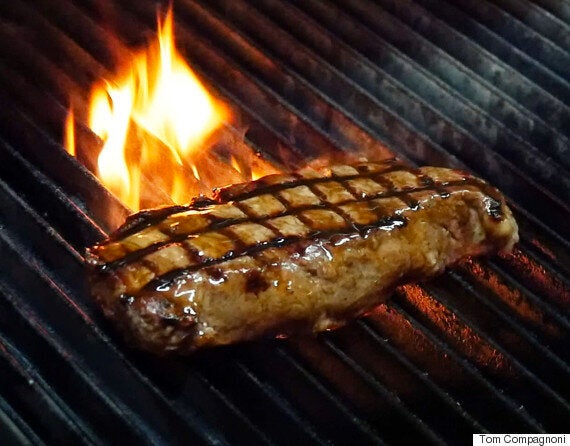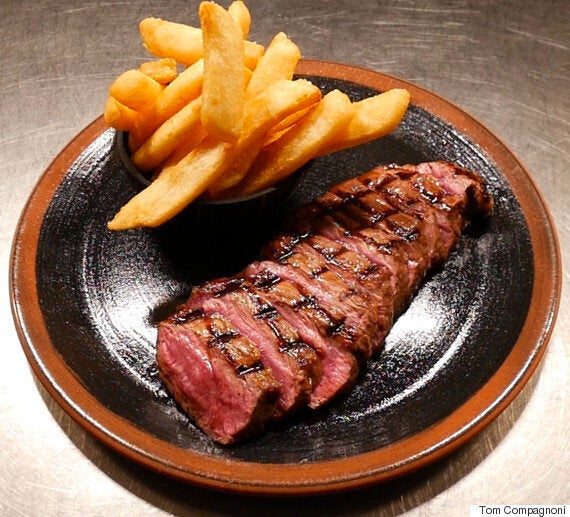Video by Tom Compagnoni
There are a lot of theories about how to cook a steak. Of course, they vary in terms of cut, utensils and cooking methods, but some questions are applicable across all categories. To season before or after, if at all? Mustard or no? How hot should the pan/hot plate/grill be? And so on and so forth.
Given many of us will no doubt be planning to enjoy a sizzling steak on Australia Day ('cause 'Straya), The Huffington Post Australia visited The Meat & Wine Co in Circular Quay for some hot (actually, very hot) tips.
"What we do, and what we think is the best type of cooking method, is to first of all take the steak and bring it to a room temperature," Wayne Solomon, Chief Food Analyst of the Seagrass Boutique Hospitality Group, told HuffPost Australia.
"Don’t take it straight from the chiller. Instead, let it sit for a couple of minutes to get the iciness off the steak," Solomon said.
"Of course you don't want to leave it for hours, but aim for room temperature. Give it a couple of minutes."
While you're waiting for your steak to un-chill, use the time to fire up your barbecue or grill.
"The biggest problem most people have at barbecues is they don’t wait for the grill to get hot enough," Solomon said. "You'll have this 350-380 degree grill, but guys will see smoke at around 220-230 degrees and think it's ready.
"The idea is to really heat the barbecue up."
Once your grill is really, really, REALLY hot, then you can start cooking your steak.
"What will normally happen is the actual griddles of the barbecue or pan will start charring the steak itself," Solomon said. "This is when people get really excited and start flipping the steak over -- which is absolutely what you don't want to do.
"What we do is we take the position -- so say if the lines on the grill are running vertically, we turn the steak 90 degrees and cross it so you actually get those cross char-marks.
"Why? Because if you keep it in the same place and don’t move it, those marks become too black and burnt. What you're doing is giving the steak a bit of reprieve."

Check out those cross marks.
Of course, the process of cooking a steak differs depending whether you'd like it rare, medium or well done.
"They all require different techniques," Solomon noted. "If you like your steak well done but you have a very thick steak, like a medallion, you’re not going to get the result you're looking for.
"You'd need to tap down the steak with meat mallet. Now, notice I said 'tap'. A lot of people hit the hell out of the steak but you don’t want to smash the meat. People think it’s a competition! But it destroys the muscle fibres in the meat, and, actually juices travel up the fibres when it cooks, so they are important.
"For a medium, you can push it with your hands, just slightly down. And rare, you don't have to even touch it."
Once you have your cross-marks, you can turn your steak (though try and refrain from flipping the steak every three seconds -- this only toughens the meat). Cook the other side and repeat a similar process.
In terms of how you like your steak cooked, Solomon said it can vary with different cuts of meat.
"If you have very fatty or marbled meat, like a wagyu, you'd want to cook it to medium plus, at least," Solomon said. "It’s only at that point, the fat starts melting and starts penetrating the meat and you get those flavours.
"If you have a wagyu cut, don’t have it rare. Well, have it however you want to, but it will be solid fat. It needs to be at least medium. Put a a little bit of light butter with a brush and salt flakes.
"That's all you need to do with your wagyu cuts -- you don’t want to baste them or you will mask the taste of the meat. Anything that is highly marbled, you want to taste those nutty beautiful fat tastes. So I'd suggest a very thin layer of butter at the end, and salt flakes. That’s beautiful."

With chippies? Stop it.
However, if you have a less fatty cut, for instance your rumps, strip loin, New Yorkers or chops -- then you can choose to baste the meat throughout the cooking process.
"As the meat has cooked on one side, turn it 90 degrees, then when you flip it, that’s when you baste the steak," Solomon said. "Flip it over again, baste again, and then finish it off with butter and salt."